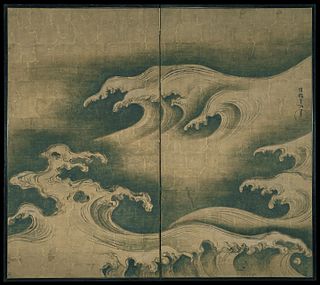 W
WByōbu (屏風) are Japanese folding screens made from several joined panels, bearing decorative painting and calligraphy, used to separate interiors and enclose private spaces, among other uses.
 W
WThe Cracked Ice screen is a late 18th-century low two-fold Japanese screen (byōbu) intended for use at the Japanese tea ceremony. It was created in the Edo period and is signed and sealed by the artist, Maruyama Ōkyo (1733–1795), founder of the Maruyama school of realist painting. It would be used as a furosaki byōbu placed near the hearth of a room used for the Japanese tea ceremony, shielding the fire from draughts and also forming a decorative backdrop behind the tea utensils. It may have been intended to be used in the summer, to evoke the cool of the winter.
 W
WCypress Trees is a Kanō-school byōbu or folding screen attributed to the Japanese painter Kanō Eitoku (1543–1590), one of the most prominent patriarchs of the Kanō school of Japanese painting. The painting dates to the Azuchi–Momoyama period (1573–1615). Now in Tokyo National Museum, it has been designated a National Treasure.
 W
WFlowering Plants of Summer and Autumn (夏秋草図屏風) is a painting on a pair of two-folded byōbu folding screens by Rinpa artist Sakai Hōitsu depicting plants and flowers from the autumn and summer seasons.
 W
WThe Hikone screen is a Japanese painted byōbu folding screen of unknown authorship made during the Kan'ei era. The 94-×-274.8-centimetre (37.0 × 108.2 in) screen folds in six parts and is painted on gold-leaf paper. It depicts people in the pleasure quarters of Kyoto playing music and games. The screen comes from the feudal Hikone Domain, ruled by the screen's owners, the Ii clan. It is owned by the city of Hikone in Shiga Prefecture, in the Ii Naochika Collection.
 W
WIrises is a pair of six-panel folding screens (byōbu) by the Japanese artist Ogata Kōrin of the Rinpa school. It depicts an abstracted view of water with drifts of Japanese irises. The work was probably made circa 1701–1705, in the period of luxurious display in the Edo period known as Genroku bunka.
 W
WRed and White Plum Blossoms is an early 18th-century painting on a pair of two-panel byōbu folding screens by Japanese artist Ogata Kōrin (1658–1716). The simple, stylized composition depicts a patterned flowing river with a white plum tree on the left and a red one on the right. The plum blossoms indicate the scene occurs in spring.
 W
WRough Waves is a painting by the Japanese artist Ogata Kōrin, on a two-panel byōbu. The work was created c. 1704 – c. 1709, and depicts a swirl of stormy sea waves. It has been in the collection of the Metropolitan Museum of Art, New York, since 1926, when it was acquired with financial support from the Fletcher Fund.
 W
WThe Pine Trees screen is a pair of six-panel folding screens by the Japanese artist Hasegawa Tōhaku. The precise date for the screens is not known, but they were clearly made in the late 16th century, in the Momoyama period, around 1595. The screens are held by the Tokyo National Museum, and were designated as a National Treasure of Japan in 1952.
 W
WTsubaki Chinzan, originally Tasuku was a Japanese painter in the nanga style. His other art names include Hekiin Sambō, Kyūan (休庵), Shikyūan (四休庵) and Takukadō (琢華堂).
 W
WWind God and Thunder God is a painting on a pair of two-folded byōbu by Rinpa artist Ogata Kōrin, a replica of a similar work by Tawaraya Sōtatsu, depicting Raijin, the god of lightning, thunder and storms in the Shinto religion and in Japanese mythology, and Fūjin, the god of wind.